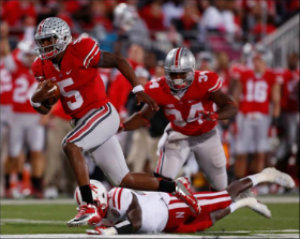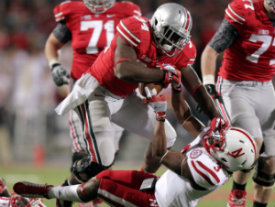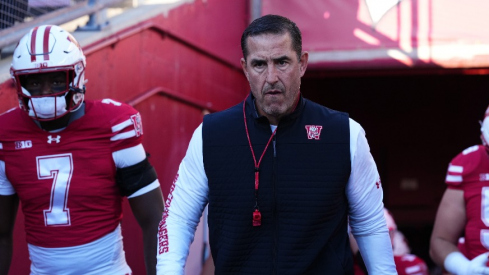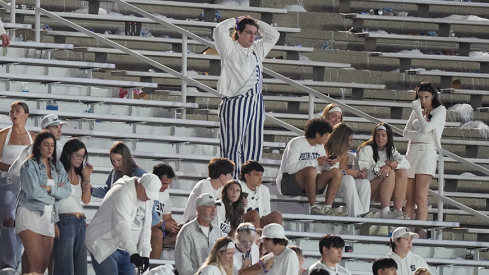Going for it on fourth down necessarily entails some degree of risk acceptance by the head coach.
 Braxton wasn't too shabby in converting fourth downs
Braxton wasn't too shabby in converting fourth downsFourth down conversions should be overwhelmingly attempted by teams that are (1) trailing and (2) in the fourth quarter. While there are certainly serial risk takers out there (interestingly, air raid teams are among the most willing to go for it), coaches often attempt fourth down conversions because their team is behind and there is a chance to win, or because there is no hope and, frankly, why not?
Stevieyo's study of 4th down conversions found that:
64 of the 87 attempts by teams trailing by more than one score above (dark red) came from teams that were, in fact, down by more than two scores, meaning my original theory was incorrect. The only justification I have to explain the numbers is that these teams are already down by such insurmountable amounts that even a failed pass attempt, and the subsequent field position of their opponent, is no longer a sufficient disincentive.
So what were Urban Meyer's 2012 Buckeyes like on fourth down? Was the points deficit ever so large that he might have well believed the Buckeyes would lose? If so, why not just sling the ball downfield or have Braxton try to make some magic on fourth?
In short, no. Meyer was in fact the best in the country at risk management on fourth downs.
Through 12 games, the Buckeyes attempted nine fourth down conversions, gaining a new set of downs on seven of those plays (77.8%). This ties Clemson for the best fourth down conversion percentage in the country.
While part of this may be explained by good judgment on when to punt versus attempt the conversion, a lot simply has to do with the relatively few fourth quarter deficits the Buckeyes faced.
Beyond Meyer's judgment and the Buckeyes' few overall attempts, the Buckeyes were undeniably proficient at converting fourth downs. Let's find out why.
The following chart displays the game circumstances of the conversion attempt (quarter, time left, and who was ahead), whether the attempt was a success, field position, yards to go, and a basic run/pass breakdown of the play.
| Game | Success? | Field Position | Yards to go | Play |
|---|---|---|---|---|
| Miami 3Q 6:43, OSU +25 | Yes | Miami 39 | 3 (5) | Guiton rush + personal foul |
| UCF 1Q 8:00, OSU +7 | No | OSU 47 | 1 (0) | Braxton rush |
| UCF 2Q 15:00, OSU +4 | Yes | OSU 50 | 1 (6) | Hyde rush |
| Neb 1Q 1:50, OSU -7 | No | OSU 25 | 7 (6) | Buchanan fake punt rush |
| Neb 2Q 1:27, OSU +4 | Yes, TD | NEB 31 | 2 (31) | Braxton rush |
| Indiana 2Q 14:46, OSU -4 | Yes | IND 47 | 1 (4) | Hyde rush |
| Purdue 1Q 9:03, OSU -6 | Yes | PUR 45 | 1 (20) | Hyde rush |
| Purdue 4Q 6:03, OSU -8 | Yes | OSU 28 | 2 (9) | Hyde rush |
| Illinois 3Q 12:31, OSU+25 | Yes | Ill 21 | 1 (2) | Hyde rush |
What is quickly apparent is that Meyer did not typically call for conversion attempts because the game was on the line. The second Hyde rush during the Purdue game was the only attempt during a fourth quarter, and it was also the largest deficit the Buckeyes faced (down eight).
Five of nine attempts were actually when the Buckeyes were leading, contrary to the "late game heroics" hypothesis. Further, six of those nine were during the first or second quarters. Meyer didn't irrationally attempt fourth down conversions, but did so when there was relatively little to lose.
 Hyde was incredible on fourth down
Hyde was incredible on fourth downThe exceptions to that rule, however, were the attempts that took place deep on the OSU side of the field. It takes great trust in your players to call for a fake punt or run up the middle on your own 25 or 28, respectively. Typically, however, Ohio State went for it on the field position you would expect – on the opponent's 45 or better. Statistically, economist Dr. David Romer found that:
Teams should try for a touchdown far more often than they actually do, he found. “This pushes for more high-stakes plays,” Romer said in a recent telephone interview, suggesting that N.F.L. coaches might also want to attempt onside kicks more frequently and call for more deep passing routes. “The football analytics push you to a more aggressive, exciting game.”
Besides Meyer's two calls deep in the Buckeyes' own territory, the Buckeyes' fourth down attempts were fairly low risk. However, though most attempts weren't high stakes, Meyer called a second fourth down attempt both times a previous attempt failed earlier in a game. In both the UCF and Nebraska games, Meyer called for a first quarter try that failed. In both circumstances, he then called for a second attempt as soon as he got the opportunity in the second quarter.
Of course, it's fairly easy to mitigate risk when Carlos Hyde has a perfect record of gaining the first on fourth down. Five Hyde rushes led to five first downs, with Carlos almost always picking up far more than the required one or two yards. Hyde is not simply a short-yardage, pound-it-up-the-middle back, but a guy that can make those eight or nine guys loading the box look silly.
Looking to next year, here's to hoping Meyer trusts the passing game enough to get even one pass attempt on fourth down.

